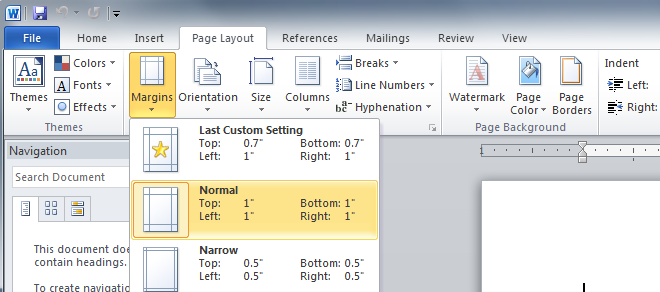

We’ve already written about how the tools we use can affect the quality and style of our work, so I like to ensure that nothing is compromised based on medium. Bleeds are what extend beyond the page and margins define where things go within the page.As designers, we would never think of actually “designing” anything in Microsoft Word - that’s what InDesign is for! Yet certain assets like presentation templates and letterheads need to be easily editable by our clients and we cannot expect them to be familiar with tools that we may use every day.įor such projects, I personally prefer starting with tools that I know will grant me creative freedom and ease of use, despite knowing that the final design will ultimately need to be recreated in Microsoft Word.
Microsoft word set up margins professional#
It can be easy to mix up margins and bleeds for professional printing and design. It preserves the intended look of the document. When a file is exported to a PDF, it saves these settings so they will not be adjusted or changed if emailed or uploaded to a server. Columns deal specifically with something called “gutters” as well – so keep a lookout for that upcoming post! They can be edited through the Layout tab by selecting “Margins and Columns” as well. Presets for mobile and web applications also have margins to give white space.Įxtra margin lines can be created by dragging them out from the top or side rulers.
Microsoft word set up margins software#
Since the software is made for more advanced typography and graphic design, margin settings are adjustable from the beginning. On Adobe InDesign things look a little different.

Once there is text in the boxes, a link will appear at the top menu that allows easy access for editing purposes. In Microsoft Word, header/footer settings can be found under the layout tab by clicking the square with an arrow to the right of the Page Setup section. Unless the color of the text is specifically changed it will still print black. In Microsoft Word, the text appears grey in the headers/footers to remind you of the specialty formatting. This keeps those elements from disrupting the flow of text. Novels often use these with the title and name of the author in the outer corners of the header. They appear on all pages in the document automatically but that can be adjusted as well. For both Microsoft Word and Google Docs, double click in those areas to type. Headers and footers are the areas above and below the margins. The clear line will appear blue during editing. Adjust margins by sliding the triangle icon on the top or side rulers. There’s also the opportunity to type in special ones and customize the page.

The simplest is the drop-down Margins menu under the layout tab. In Microsoft Word, margins can be adjusted in many ways. A resume and a recipe card would have different edge sizes based on their function. The software also allows personalization and editing for various document types. Microsoft Word, Google Docs, and most other online writing tools have automatic margins set up 1 inch away from the edge of the page. They also keep the text within the bounds home and office printers can print. For design purposes, they keep the layout from looking messy or cluttered. The empty “white space” gives the eye an empty space to land. Margins are the invisible lines on the four sides of a page creating a box for text.


 0 kommentar(er)
0 kommentar(er)
